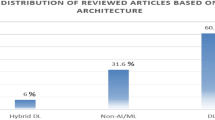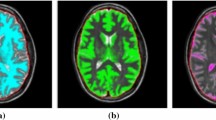Abstract
Automatic brain tumor segmentation in magnetic resonance images (MRIs) is an essential stage for treatment planning. However, MR image segmentation is challenging owing to non-uniformity in the intensity distribution, tumor shape, size, and location variation. The paper proposes a new level set method that is called Fuzzy Kernel Level Set (FKLS) for 3D brain tumor segmentation in MR images. To avoid computational complexity, fast bounding box based on symmetry analysis is used to extract the volume of interest (VOI) in brain MRIs. Then, a level set method is proposed based on fuzzy c-means clustering and kernel mapping. A kernel function is used to transfer the image into another domain, where the new proposed functional is minimized. To assess the proposed FKLS method, a synthetic image and natural brain MR images from BraTS 2017 are segmented. Experimental results show that our method is superior to the state-of-the-art segmentation methods regarding the segmentation accuracy based on Dice, Jaccard, Sensitivity, and Specificity metrics. The mean values of these metrics are 97.62% \(\pm\)(0.94%), 95.41% \(\pm\)(1.8%), 98.79% \(\pm\) (0.63%), and 99.85% \(\pm\) (0.09%), respectively.









Similar content being viewed by others
References
Amarapur B (2019) Cognition-based MRI brain tumor segmentation technique using modified level set method. Cogn Technol Work 21(3):357–369
Aswathy SU, Dhas GG, Kumar SS (2015) Quick detection of brain tumor using a combination of EM and level set method. Indian J Sci Technol 8(34)
Bahadure NB,Ray AK, Thethi HP (2017) Image analysis for MRI based brain tumor detection and feature extraction using biologically inspired BWT and SVM. Int J Biomed Imaging
Bakas S et al (2017) Advancing the cancer genome atlas glioma MRI collections with expert segmentation labels and radiomic features. Sci Data 4:170117
Bakas S et al (2017) Segmentation labels and radiomic features for the pre-operative scans of the TCGA-GBM collection. The Cancer Imaging Archive 2017, 286
Bezdek JC, Ehrlich R, Full W (1984) FCM: The fuzzy c-means clustering algorithm. Comput Geosci 10(2–3):191–203
Castillo LS et al (2017) Volumetric multimodality neural network for brain tumor segmentation. In: 13th International Conference on Medical Information Processing and Analysis. International Society for Optics and Photonics
Catà M et al (2017) Masked V-Net: an approach to brain tumor segmentation. In: 2017 International MICCAI BraTS Challenge. Pre-conference proceedings
Chan TF, Vese LA (2001) Active contours without edges. IEEE Trans Image Process 10(2):266–277
Chen Y, Wu M (2019) A level set method for brain MR image segmentation under asymmetric distributions. Signal Image Video Process 13(7):1421-1429
Essadike A, Ouabida E, Bouzid A (2018) Brain tumor segmentation with Vander Lugt correlator based active contour. Comput Methods Programs Biomed 160:103-117
Fang L, Wang X, Wang L (2020) Multi-modal medical image segmentation based on vector-valued active contour models. Inf Sci 513:504–518
Hasan AM et al (2016) Segmentation of brain tumors in MRI images using three-dimensional active contour without edge. Symmetry 8(11):132
Hashemzehi R, Mahdavi SJ, Kheirabadi M, Kamel SR (2020) Detection of brain tumors from MRI images base on deep learning using hybrid model CNN and NADE. Biocybern Biomed Eng 40(3):1225–1232
Hussain S, Anwar SM, Majid M (2018) Segmentation of glioma tumors in brain using deep convolutional neural network. Neurocomputing 282:248–261
Ibrahim RW, Hasan AM, Jalab HA (2018) A new deformable model based on fractional Wright energy function for tumor segmentation of volumetric brain MRI scans. Comput Methods Programs Biomed 163:21–28
Ilunga–Mbuyamba E et al (2017) Automatic selection of localized region-based active contour models using image content analysis applied to brain tumor segmentation. Comput Biol Med 91:69–79
Ilunga-Mbuyamba E et al (2017) Localized active contour model with background intensity compensation applied on automatic MR brain tumor segmentation. Neurocomputing 220:84–97
Işın A, Direkoğlu C, Şah M (2016) Review of MRI-based brain tumor image segmentation using deep learning methods. Procedia Comput Sci 102:317–324
Kamnitsas K et al (2017) Ensembles of multiple models and architectures for robust brain tumour segmentation. In: International MICCAI Brainlesion Workshop. Springer, Berlin
Karnawat A et al (2017) Radiomics-based convolutional neural network (radcnn) for brain tumor segmentation on multi-parametric MRI. In: Proceedings of MICCAI-BraTS Conference, Canada
Kass M (1988) Active Witkin models and demetri Terzopoulos: “Snakes: Active Contour Models”. Int J Comput Vis
Kumar S, Mankame DP (2020) Optimization driven Deep Convolution Neural Network for brain tumor classification. Biocybern Biomed Eng 40(3):1190–1204
Li C et al (2007) Implicit active contours driven by local binary fitting. in Proceedings of the energy [C], IEEE Conference on Computer Vision and Pattern Recognition
Li C et al (2008) Minimization of region-scalable fitting energy for image segmentation. IEEE Trans Image Process 17(10):1940–1949
Li C et al (2011) A level set method for image segmentation in the presence of intensity inhomogeneities with application to MRI. IEEE Trans Image Process 20(7):2007–2016
Li Q et al (2018) Glioma segmentation with a unified algorithm in multimodal MRI images. IEEE Access 6:9543–9553
Li C, Gore JC, Davatzikos C (2014) Multiplicative intrinsic component optimization (MICO) for MRI bias field estimation and tissue segmentation. Magn Reson Imaging 32(7):913–923
Lok KH et al (2017) Fast and robust brain tumor segmentation using level set method with multiple image information. J X-Ray Sci Technol 25(2):301–312
Lopez MM, Ventura J (2017) Dilated convolutions for brain tumor segmentation in MRI scans. In: International MICCAI Brainlesion Workshop. Springer, Berlin
Lorenzo PR et al (2019) Segmenting brain tumors from FLAIR MRI using fully convolutional neural networks. Comput Methods Programs Biomed 176:135–148
Ma D et al (2019) Adaptive local-fitting-based active contour model for medical image segmentation. Sig Process Image Commun 76:201–213
Maharjan S et al (2020) A novel enhanced softmax loss function for brain tumour detection using deep learning. J Neurosci Methods 330:108520
Mahata N, Sing JK (2020) A novel fuzzy clustering algorithm by minimizing global and spatially constrained likelihood-based local entropies for noisy 3D brain MR image segmentation. Appl Soft Comput 90:106171
Meng X et al (2017) Brain MR image segmentation based on an improved active contour model. PLoS ONE 12(8):e0183943
Menze BH et al (2014) The multimodal brain tumor image segmentation benchmark (BRATS). IEEE Trans Med Imaging 34(10):1993–2024
Mittal M et al (2019) Deep learning based enhanced tumor segmentation approach for MR brain images. Appl Soft Comput 78:346–354
Naser MA, Deen MJ (2020) Brain tumor segmentation and grading of lower-grade glioma using deep learning in MRI images. Comput Biol Med 121:103758
Özyurt F et al (2019) Brain tumor detection based on Convolutional Neural Network with neutrosophic expert maximum fuzzy sure entropy. Measurement 147:106830
Raja PS (2020) Brain tumor classification using a hybrid deep autoencoder with Bayesian fuzzy clustering-based segmentation approach. Biocybern Biomed Eng 40(1):440–453
Rehman ZU et al (2019) Fully automated multi-parametric brain tumour segmentation using superpixel based classification. Expert Syst Appl 118:598–613
Saba T et al (2020) Brain tumor detection using fusion of hand crafted and deep learning features. Cogn Syst Res 59:221–230
Saha BN et al (2012) Quick detection of brain tumors and edemas: A bounding box method using symmetry. Comput Med Imaging Graph 36(2):95–107
Salah MB, Mitiche A, Ayed IB (2009) Effective level set image segmentation with a kernel induced data term. IEEE Trans Image Process 19(1):220–232
Saouli R, Akil M, Kachouri R (2018) Fully automatic brain tumor segmentation using end-to-end incremental deep neural networks in MRI images. Comput Methods Programs Biomed 166:39–49
Shahvaran Z et al (2012) Region-based active contour model based on Markov random field to segment images with intensity non-uniformity and noise. J Med signals Sens 2(1):17
Shahvaran Z, Kazemi K, Helfroush MS (2016) Simultaneous vector-valued image segmentation and intensity nonuniformity correction using variational level set combined with Markov random field modeling. SIViP 10(5):887–893
ŞİŞİK F, Eser S (2020) Brain tumor segmentation approach based on the extreme learning machine and significantly fast and robust fuzzy C-means clustering algorithms running on Raspberry Pi hardware. Med Hypotheses 136:109507
Soltaninejad M et al (2018) Supervised learning based multimodal MRI brain tumour segmentation using texture features from supervoxels. Comput Methods Programs Biomed 157:69–84
Soltaninejad M et al (2019) MRI brain tumor segmentation using random forests and fully convolutional networks. arXiv preprint arXiv:1909.06337
Song Y et al (2017) A novel brain tumor segmentation from multi-modality MRI via a level-set-based model. J Signal Process Syst 87(2):249–257
Zhao X et al (2018) A deep learning model integrating FCNNs and CRFs for brain tumor segmentation. Med Image Anal 43:98–111
Author information
Authors and Affiliations
Corresponding authors
Additional information
Publisher’s Note
Springer Nature remains neutral with regard to jurisdictional claims in published maps and institutional affiliations.
Rights and permissions
About this article
Cite this article
Khosravanian, A., Rahmanimanesh, M., Keshavarzi, P. et al. Level set method for automated 3D brain tumor segmentation using symmetry analysis and kernel induced fuzzy clustering. Multimed Tools Appl 81, 21719–21740 (2022). https://doi.org/10.1007/s11042-022-12445-7
Received:
Revised:
Accepted:
Published:
Issue Date:
DOI: https://doi.org/10.1007/s11042-022-12445-7




